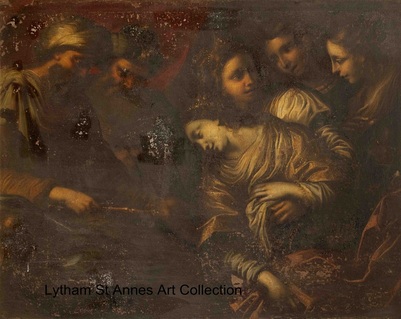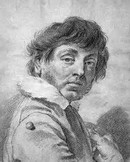Esther and Ahasuerus
|
Research by Marjorie Gregson
|
|
ARTIST
Carlo Cignani was an Italian Baroque artist born to a noble family in Bologna in 1628. He studied in his home city, first under Battista Cairo and later under Francesco Albani, becoming his most famous pupil. At the same time he was greatly influenced by the teaching of Carracci and by the work of Correggio and Melozzo da Forli. His first important work, for Cardinal Farnese, was the ornamentation of the great salon of his palace in Bologna. He also painted scenes in the style of Correggio depicting events in Bologna at the time of the plague. They are in the church of San Michele in Bosco. He was a slow-working perfectionist who was known to employ assistants for his decorative commissions. His four groups of angels are seen as models of delicacy in the painting of flesh. Later, he opened an academia del nudo for painting from models and had Giuseppe Maria Crespi as one of his pupils. Cignani also executed a fine piece of interior decoration in the palace of the Duke of Parma. His masterpiece, The Assumption of the Virgin, is around the cupola of the Church of the Madonna del Fuoco at Forli. This great work occupied him for some twenty years. On its completion he was elected to high office in that town and appointed president of the Academy of Bologna by Clement X1. In 1686 he moved to Forli where he died in 1719. He was given a magnificent funeral in both Forli and Bologna. Cignani was posthumously elected Principe in absencia for life by the Accademia Clementina for Bolognese artists. Highly regarded internationally, his work is to be seen in many galleries. His son, Felice Cignani (1660-1724), and nephew, Paola Gignani (1709-1764), were also painters. In addition to the above, his principal works include: Entry of Paul III into Bologna Francis I Touching for Kings Evil; a power of love 2 x Joseph and Potiphar’s Wife (at Dresden and Copenhagen) Adam and Eve (The Hague) A Putto with Tambourine and an Infant Satyr with a Panpipe (Ashmolean Museum) PAINTING According to the Book of Esther, the Persian King Ahasuerus (also known as Xerxes) ruled over 127 provinces stretching from India to Ethiopia. In the third year of his reign he decided to celebrate his rule with a party. However, in a drunken stupor he commanded his wife, Queen Vashti, to appear before him and the court 'wearing her royal crown'. Over the centuries this command had been interpreted to mean only her crown. She refused and Ahasuerus was so furious he decided to replace her. He held a kingdom-wide beauty pageant in order to select a new queen from the most beautiful women in his realm. Eventually, he picked Esther to fill that role. She was a Jewess but this was unknown to him. Haman, second in power, talked the king into ridding the kingdom of Jews so Esther appeared before the king to plead for her people. In this she was breaking court etiquette and risked death but her request found favour and she has been revered as a heroine ever since. The powerful painting shows her fainting in the king’s presence, knowing her fate was in his hands. She is being supported by the ladies at court whose faces show their care and concern. The bravery of Queen Esther has been portrayed by many artists. DONOR The donor was Jane Agnew Smith, widow of Randolph Smith. She was born in 1875 in Chorlton, Lancashire to Andrew Hannay, a biscuit manufacturer, and his wife, Jane Agnew (nee Rankin) . Randolph was born in 1868 in Eccles, Lancashire to Joshua and Betsy Martha Smith. The couple married in 1897 and in 1901 were living in Worsley with their three daughters and two servants. The 1911 census shows they were living on North Promenade, St Annes, at which time his occupation was that of a cloth manufacturer. Randolph died in 1913 and this was reported in the Manchester and Lancashire General Advertiser along with details of his estate and describing him as a director of Messrs Joshua Smith Limited, cotton merchants. According to Barrett's Directory, Jane was living at 9 Headroomgate, St Annes in 1934 and it was still her place of residence when she donated the painting in 1942. |
REFERENCES
www.wikipedia.org www.artcyclopedia.com www.findmypast.co.uk Barrett’s Directory www.amounderness.co.uk www.metmuseum.org |


